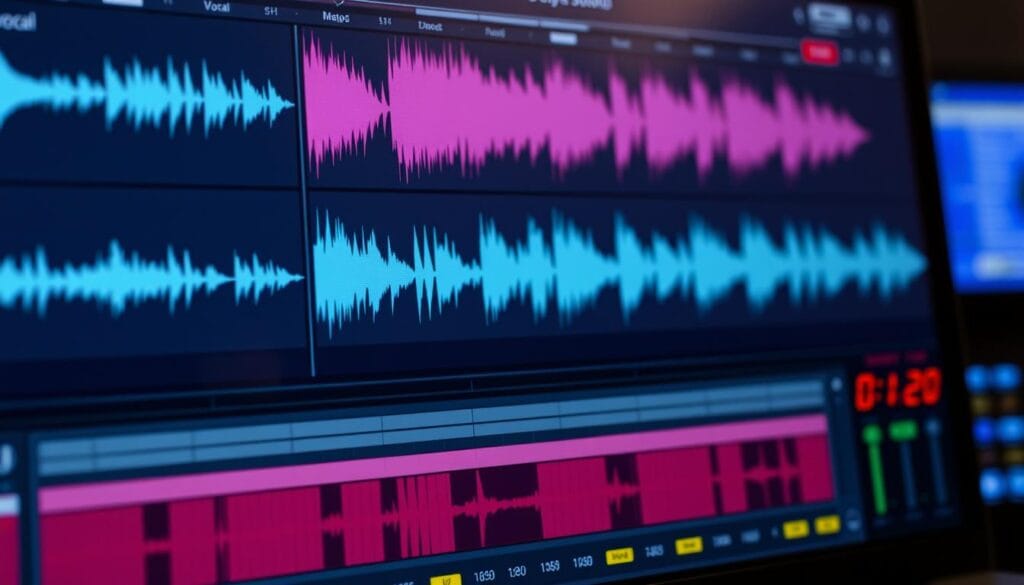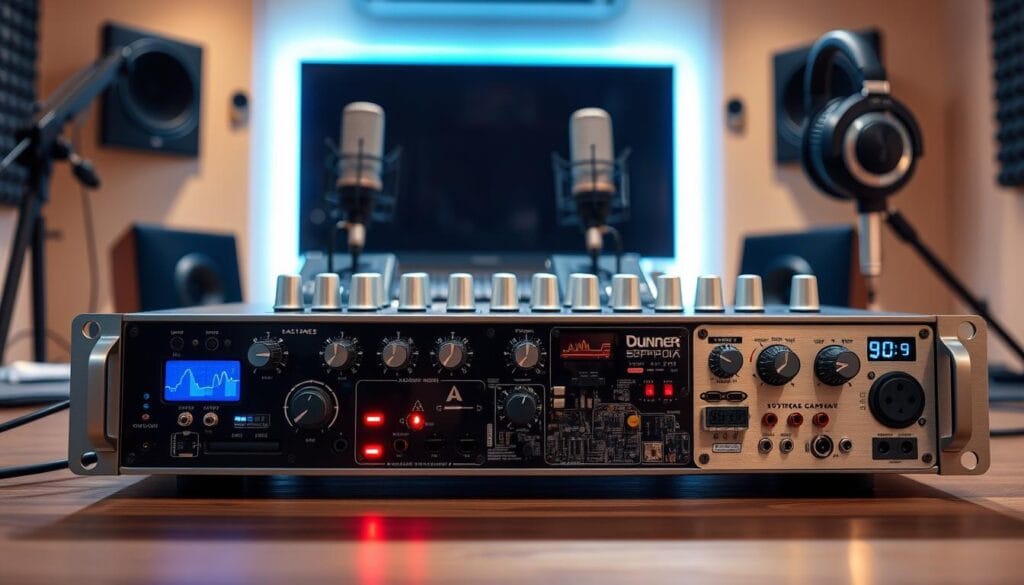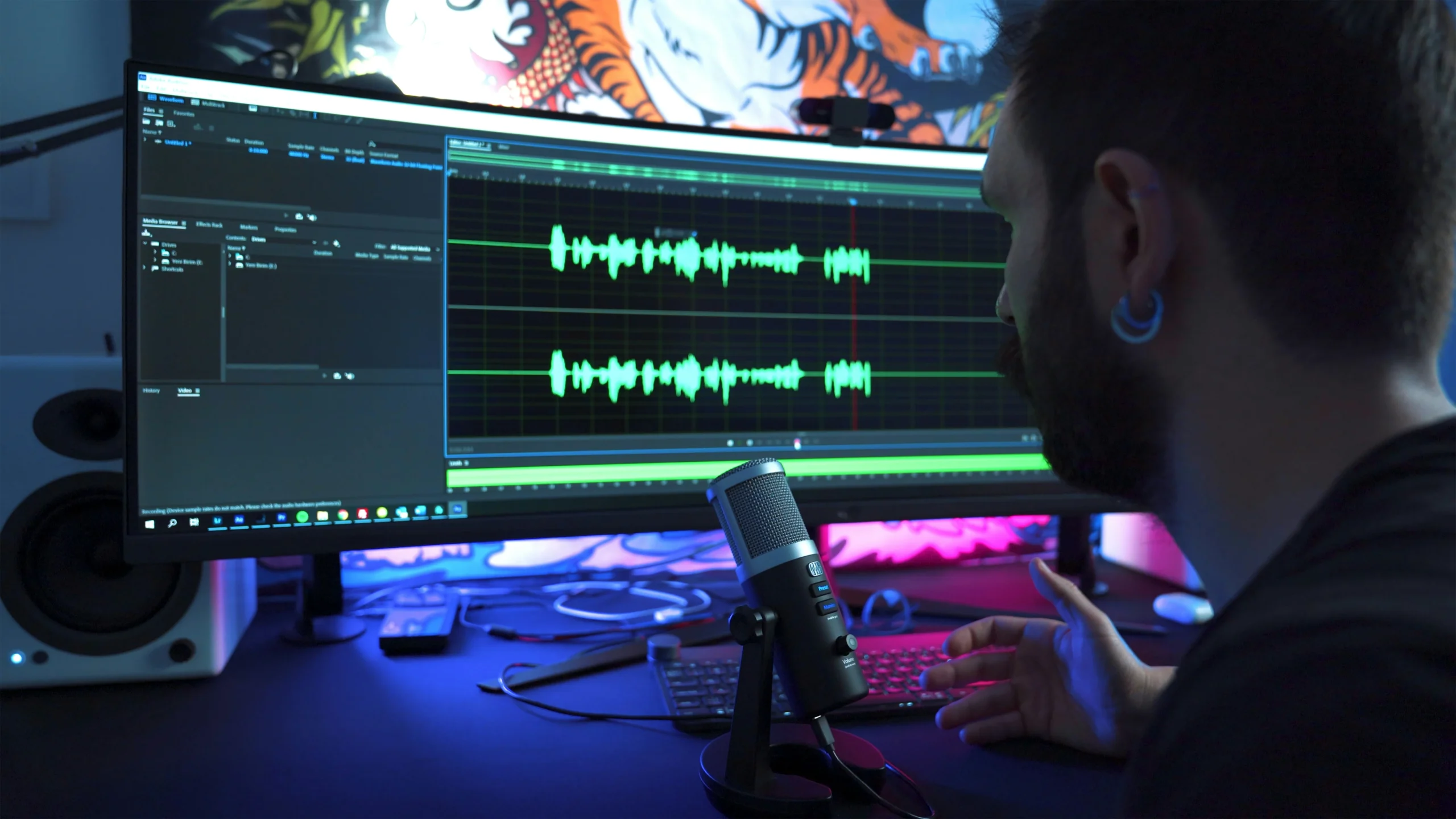Ever recorded a song, only to hear it sounds a bit off? You’re not alone. It’s frustrating when your recordings seem delayed. This can mess up your creative flow, whether you’re new or experienced.
Imagine recording a track full of emotion, but it sounds delayed. This is a common problem. It can be due to hardware, software, or digital audio workstation (DAW) issues.
Technical problems shouldn’t ruin your work. Keep the vocalist about an arm’s length from the mic for clearer sounds. Also, make sure there’s enough space to avoid a boomy sound. Recording whole verses and choruses helps keep things smooth. We’ll show you how to fix these issues.
First, let’s figure out why these delays happen. Knowing this helps you choose the right solutions for better recordings.
Table of Contents
Understanding Vocal Recording Delay
To understand how latency affects your sessions, it’s key to know what latency is. It’s also important to see why timing is crucial in your recordings.
Defining Latency
Latency, or delay, is the time from when you start recording (like singing into a mic) to when you hear it back. This delay can range from milliseconds to seconds. It affects how well your recordings sound together.
When latency problems happen, they mess with the timing of your recordings. This can make your recordings sound off, affecting their quality and how well they work together.
Importance of Timing in Recordings
Getting the timing right is key to good vocal recording. It keeps the rhythm and timing of your tracks in sync. This is essential for a sound that’s both harmonious and professional.
For example, setting delay effects to match your song’s tempo is a good idea. Using high pass filters on delay effects can also make your vocals clearer. This is important in all kinds of music.
Fixing latency issues can greatly improve your recordings. Try adjusting delay times and feedback levels to get a clear echo. Playing with different delay settings and filtering out high frequencies can also make your sound more natural. This shows how mastering delay is more versatile and impactful than reverb.
Primary Causes of Vocal Recording Delay
Fixing vocal recording delay means solving several problems. These are key to solving latency issues. Let’s look at the main causes of these delays.
Buffer Size in DAWs
The buffer size in your Digital Audio Workstation (DAW) is a big problem. If it’s too high, you’ll get big delays. But if it’s too low, you might get audio glitches. Changing the buffer size is important to fix delays.
Audio Interface Issues
Bad or broken audio interfaces can ruin your recordings. They turn analog signals into digital and back. Having a good audio interface and setting it right is vital. Problems with devices like the Denon SC Live 4 show the impact of bad interfaces.
Software and Driver Settings
Your software and drivers must be current and set right to avoid delays. Old drivers or wrong settings can cause problems. For example, adjusting Quality of Service (QoS) settings or updating your DAW can help.
Hardware Limitations
At times, your hardware can’t handle good audio processing. This might be because of not enough RAM, an old CPU, or other issues. Upgrading your hardware is key to reducing latency and getting smooth recordings.
How Buffer Size Affects Latency
Understanding how buffer size and latency are connected is key for top-notch vocal recording in your studio. Changing buffer sizes can greatly affect the delay you feel during recording.
Optimizing Buffer Settings
Buffer size shows how much audio data your computer handles at once. Smaller buffers can cut down latency but might cause problems. Your system could struggle, leading to audio issues.
For optimal settings, start with a medium buffer size. Gradually lower it to see how it affects latency and sound quality. Online resources, like YouTube tutorials, can help you find the right balance.
Balancing Power and Performance
Finding the right balance between low latency and system stability is crucial. In home studios, reducing latency can take up a lot of time. Your system’s power, multitasking, and other factors impact performance.
Dynamic microphones might need pre-preamps like Cloudlifter or FetHead to boost signals. This can help reduce latency. For some, using pre-preamps is worth it to keep recording quality high.
When tweaking buffer sizes, think about your hardware too. Lowering buffers too much on a weak computer can cause big problems. But, on stronger systems, you can use smaller buffers without losing stability.
why do my vocal recordings sound delayed?
Vocal recording delay is a common problem for artists and producers. It can really mess up your sound. Different DAWs process audio in their own ways, which can cause delays and affect your recordings.

Common Issues in Different DAWs
DAWs handle audio differently, especially with buffer sizes and audio drivers. For example, Logic Pro has a Low Latency Mode to reduce delays from plug-ins. This keeps delays under a certain time limit.
Smaller buffer sizes can lower input monitoring latency but might cause system overload alerts.
| DAW | Latency Management Techniques |
|---|---|
| Logic Pro | Low Latency Mode, smaller buffer sizes |
| Pro Tools | High-performance power plan, exclusive mode activation |
| FL Studio | Adjustable sample rates, Voicemod adjustments |
Using dynamics plug-ins with look-ahead can also cause delays. Make sure your input and output sample rates are the same. This usually means 16 bits at 48000Hz to reduce latency and improve your recordings.
Impact of High Latency on Recording Quality
High latency can mess up the timing and precision of your vocals. A delay of about 25ms is good for stereo separation. This makes your vocal tracks sound better without any noticeable delays.
Getting the right feedback percentage, like 25% for stereo separation delay, makes your mix more dynamic.
It’s better to use wired connections instead of wireless networks to avoid latency. Also, use high-performance power plans and make sure other apps aren’t using too much CPU. This will help improve your vocal recording quality.
Audio Interface Solutions for Reducing Delay
Reducing latency is key for top-notch audio recordings. Optimizing your audio interface settings is crucial. High-quality interfaces and the right ASIO drivers can make a big difference. Let’s dive into these important topics.
Importance of ASIO Drivers
ASIO drivers help your audio software and hardware talk directly. This cuts down the time it takes for audio to move through your system. For example, the Focusrite Clarett 2Pre Thunderbolt interface has a latency of 1.67ms.
This is better than the Scarlett 2i2 USB 3.0 interface’s 2.74ms. Using ASIO drivers lets your system handle bigger buffer sizes and sample rates. This reduces latency even more.
Direct Monitoring Features
Direct monitoring is another key feature. It lets vocalists hear their input signal right away, without DAW processing. This is great for keeping timing and performance quality high.
Brands like Focusrite, Universal Audio, and RME offer interfaces with strong direct monitoring. This feature is essential for instant playback of the input sound.
Here’s a table showing latency differences between Thunderbolt and USB interfaces:
| Audio Interface | Connection Type | Latency (ms) | Buffer Size (Samples) | Sample Rate (kHz) |
|---|---|---|---|---|
| Focusrite 2i2 | USB 3.0 | 2.74 | 256 | 88.2 |
| Clarett 2Pre | Thunderbolt | 1.67 | 64 | 96 |
In conclusion, picking the right audio interface with ASIO drivers and direct monitoring is vital. Low buffer sizes and high sample rates help keep latency low. This makes your recordings smooth and professional. Upgrading your system and tweaking settings can help keep latency under 10 milliseconds for the best sound.
Troubleshooting Software Settings
Fixing software settings can really help with delayed vocal recordings. A key part is updating and configuring your drivers for the best performance. It’s important to keep your audio drivers current to avoid latency. Outdated drivers can slow down your audio processing.
We’ll cover two main steps: updating and configuring drivers, and tweaking DAW preferences for your recording setup.
Updating and Configuring Drivers
First, make sure you have the latest driver updates for better recording. Manufacturers often release updates to fix issues and add new features. These updates can make your recordings more stable and low-latency.
Always get drivers from your audio interface’s official website. Also, keep your system’s operating system up to date. This can improve your audio performance even more.
Optimizing DAW Preferences
Next, adjust your DAW settings to reduce latency. Lowering the buffer size in your DAW is a good start. Aim for a buffer size between 64 to 256 samples for better performance.
When tweaking DAW settings, try using higher sample rates like 88.2kHz or 96kHz. This can lower latency. Use the formula Buffer size ÷ Sample rate = Latency in seconds to find the right balance.
Also, optimize your PC for audio production. Disable unnecessary background processes and set your PC to high performance. This can help a lot.
Lastly, use the best drivers for your audio interface. For example, the Focusrite Clarett 2Pre Thunderbolt interface has a latency of 1.67ms. This is much lower than the Scarlett 2i2 USB 3.0 interface’s 2.74ms. Regularly updating and configuring these settings is key for great vocal recordings.
Best Practices for Reducing Latency
To get the best vocal recordings, cutting down latency is key. Knowing how network setups and browser choices affect your recording is important.
Using Wired Connections Over Wireless
Wired connections are better for reducing latency. They offer stable and fast data transfer, unlike wireless which can be slow and interrupted. Ethernet cables keep your connection strong, reducing any issues that might mess up your recording.
For example, using the Lindell 80 channel strip can add clarity to your vocals. But, a bad connection can mess up its effect. Also, using compressors and high-pass EQ helps keep your vocals clear. Microphones connected in “exclusive mode” also help with low latency, making audio processing smoother.
Choosing the Right Browser for Browser-Based DAWs
Choosing the right browser for recording is crucial. Browsers like Google Chrome or Mozilla Firefox are best because they handle audio well. They help keep your recordings in sync.
A study by Reidy showed that the Focusrite Clarett 2Pre had a latency of 1.67ms. The Scarlett 2i2 had a latency of 2.74ms. This highlights the need for good hardware and browser performance. Always pick audio interfaces with latency under 10ms for the best results.
By following these tips, you can improve your recording setup. This means better and more timely vocal captures. Here are some key recommendations:
| Recommendation | Benefit |
|---|---|
| Use Wired Connections | Ensures stable and faster data transfer, reducing latency. |
| Choose Optimized Browsers | Handles real-time audio processing efficiently, maintaining sync. |
| Employ High-Quality Audio Interfaces | Minimizes latency, ensuring optimal performance. |
| Configure Network Settings | Improves overall recording quality and reliability. |
Advanced Techniques for Minimizing Delay
Reducing latency in vocal recordings is key to keeping your performance quality high. Using advanced strategies and top-notch audio interfaces can greatly cut down delay. This ensures a smooth recording process.

Utilizing Dedicated Audio Interfaces
Pro Tools Low Latency Monitoring is vital for recording and mixing. It reduces the delay between input and output signals. This makes it easier to track live instruments, record vocals, and overdubs without delay.
Investing in advanced audio interfaces with strong preamps and low-latency features can greatly enhance your setup.
Techniques for Monitoring and Processing
Real-time monitoring lets performers hear their tracks without delay. This is crucial for natural sound and timing. Key practices include:
- Setting the right buffer sizes in your DAW for balance.
- Using direct monitoring on many advanced audio interfaces.
- Trying different monitoring setups for the best results in your environment.
By fixing common issues like adjusting buffer sizes and monitoring CPU usage, you keep performance high. These advanced techniques help you get top-quality recordings while overcoming latency challenges.
Impact of Computer Performance on Recording Latency
Latency in recording can cause delays between a musician’s performance and what they hear in their headphones. This affects the groove and tightness of music. To manage these delays, it’s key to have the right computer specs for recording.
By focusing on RAM, CPU, and closing unnecessary apps, you can boost your DAW’s performance. This makes your recording sessions smoother.
Importance of RAM and CPU
RAM and CPU play a big role in reducing latency during recording. More RAM means smoother multitasking. A strong CPU quickly processes audio data.
Lowering the buffer size in your DAW can help with latency. But, this might strain the CPU. So, having a high-performance processor is crucial.
High sample rates improve audio quality but can be hard on RAM and CPU. This shows how important they are.
Running DAWs Efficiently
To optimize DAW performance, you need to fine-tune settings. Lower buffer sizes, like 64 samples, can reduce latency to under 10ms. This is great for monitoring audio inputs and playing VSTis.
But, lower buffer sizes require more CPU power. So, your system’s CPU must be strong enough to handle it without glitches or dropouts. Using dedicated audio interfaces with optimized drivers also helps reduce latency, making recording smoother.
Closing Unnecessary Applications
One simple yet effective way to improve DAW performance and reduce latency is to close apps you don’t need. These apps can use up CPU and RAM, slowing things down.
By freeing up resources, your DAW can run better and handle audio processing in real-time. This is especially important at high sample rates or in live performances where latency must be low.
| Parameter | Suggested Setting |
|---|---|
| RAM | 16GB or higher |
| CPU | Intel i7 or AMD equivalent |
| Buffer Size | 64 Samples |
| Audio Interface | Focusrite, MOTU, or RME |
Conclusion
Understanding the many factors that cause vocal recording delays is key to getting clear recordings. Managing buffer sizes in your DAW and fixing audio interface problems are important steps. Each one helps solve vocal recording delays.
Make sure your hardware and software are set up right. This can make a big difference.
Following best practices can also help a lot. Use wired connections instead of wireless and pick the right browser for your DAW. Using dedicated audio interfaces and good monitoring methods also improves vocal clarity and timing.
Don’t forget how your computer affects recording latency. Upgrading RAM and CPU and closing unused apps can make your DAW work better. By using these strategies, you can solve vocal recording delays and get clear recordings. This will make your music, podcasts, or voice-overs sound professional.
FAQ
Why do my vocal recordings sound delayed?
Delayed vocal recordings often come from high latency. This is the time it takes for audio to go from the mic to your computer and back. Issues like wrong buffer sizes, poor audio interfaces, old software, and weak hardware are common causes.
How can I fix delayed vocal recordings?
To fix delayed vocals, start by adjusting buffer sizes. Use a top-notch audio interface with low-latency drivers. Make sure your software and drivers are updated and your hardware can handle quality audio. Direct monitoring and wired connections also help.
What is latency in vocal recording?
Latency, or delay, is the time from when you start singing into a mic to when you hear it back. It’s key for keeping your vocals in sync with other tracks.
Why is timing important in vocal recordings?
Timing is key for keeping your vocals in rhythm. If your vocals and playback aren’t in sync, it can mess up your recording quality and creativity.
How does buffer size affect vocal recording latency?
Buffer size controls how much audio your computer processes at once. A smaller buffer size can lower latency but might cause system overload. Finding the right balance is crucial for good performance and sound quality.
What are common issues in different DAWs that affect vocal recording?
Each DAW handles audio differently, which can lead to latency issues. High latency can make your tracks sound out of sync, affecting recording quality.
How can audio interfaces help reduce delay?
Professional audio interfaces with ASIO drivers can greatly reduce latency. ASIO drivers are made for pro audio, speeding up data processing. Direct monitoring lets you hear your performance without DAW delay.
How important is updating and configuring drivers for reducing latency?
Keeping drivers current is vital for low latency. Old drivers slow down audio processing. Proper driver setup and DAW preferences can also cut down on delays.
What best practices should I follow to reduce latency?
To lower latency, use wired connections and pick browsers good for audio in DAWs. Also, close apps you don’t need to free up resources.
What advanced techniques can minimize delay in vocal recordings?
For less delay, use audio interfaces made for low latency and real-time monitoring. This ensures high-quality recordings without noticeable delays.
How does computer performance impact recording latency?
Your computer’s specs, like RAM and CPU, affect latency. Running DAWs efficiently and closing unused apps can reduce delays and make recording smoother.
